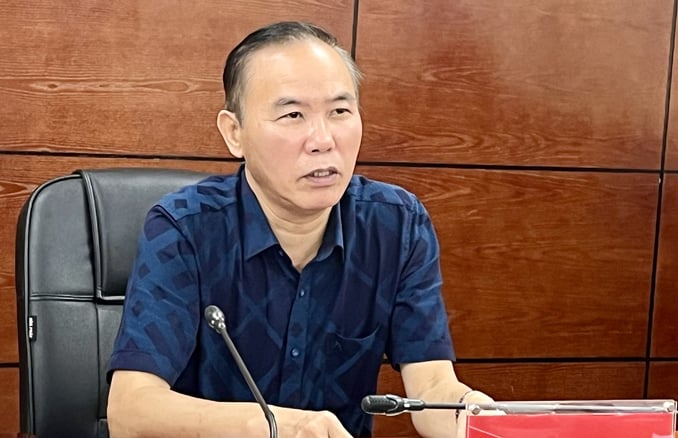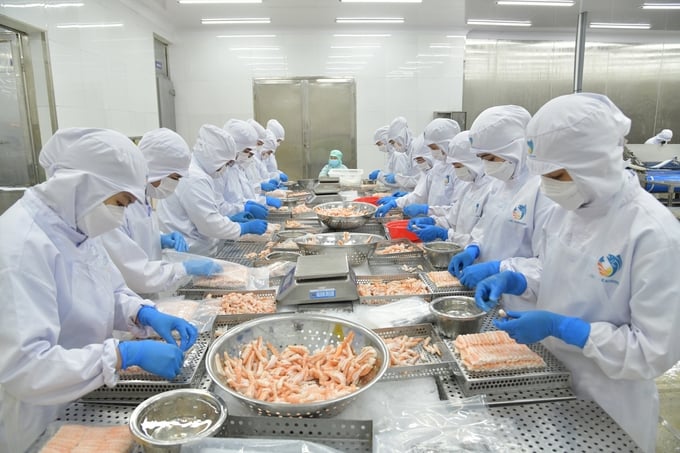November 28, 2025 | 05:35 GMT +7
November 28, 2025 | 05:35 GMT +7
Hotline: 0913.378.918
November 28, 2025 | 05:35 GMT +7
Hotline: 0913.378.918
During the August briefing at the Directorate of Fisheries on September 6, Deputy Minister of Agriculture and Rural Development Phung Duc Tien reported that aquacultural exploitation and production output experienced a slow increase of 1.9% within the first eight months of 2023. Despite the stable output, the export of seafood was faced with numerous challenges. Accordingly, Deputy Minister Phung Duc Tien raised the question of solutions to maintain both the growth of seafood exports and the source of raw materials.

Deputy Minister of Agriculture and Rural Development Phung Duc Tien reported that the fisheries sector contributed significantly to the strong growth of the agricultural sector within the first eight months of 2023. Photo: Hong Tham.
According to Mr. Tran Dinh Luan, General Director of the Directorate of Fisheries, the total seafood production output reached approximately 5.93 million tons in the first eight months of 2023, which is an increase of 1.9% over the same period in 2022.
Most notably, aquacultural exploitation output is estimated at more than 2.63 million tons, which is an increase of 0.3% over the same period in 2022. This volume includes 2.5 million tons from marine fishing and 123 thousand tons from domestic fishing. Aquacultural production output is estimated at nearly 3.3 million tons, which is an increase 3.2% over the same period. This volume includes over 1079 thousand tons of pangasius, an increase of 2.3%; over 718 thousand tons of shrimp, an increase of 4.1%.
Regarding the state of the seafood industry in the first eight months of 2023, Mr. Luan commented that growth was stable but exports were limited. According to a report by the Directorate of Fisheries, the total seafood export turnover reached 5.68 billion USD in the first eight months of 2023, which is a decrease of 25.4% over the same period in 2023.
According to Mr. Vu Duyen Hai, Head of Aquacultural Exploitation under the Directorate of Fisheries, Vietnam's aquacultural exploitation was limited in the first half of 2023 due to the influence of El Nino. Additionally, widespread labor shortage put 20 to 30% of the fishing vessels out of commission. However, aquacultural exploitation output reached over 2.6 million tons, which is a small increase compared to the same period in 2022. Despite the emerging rainy season, the aquacultural sector may still reach its exploitation target.
According to Mr. Hai, seafood orders are on declining trend worldwide. However, orders from China and Japan are increasing after Japan discharged water from its nuclear power plants. The demand for seafood on the global market has been projected to increase in the immediate future, especially during the upcoming Christmas and New Year holidays.
According to Mr. Ngo The Anh, Head of Aquacultural Production, environmental conditions for aquacultural production have been relatively favorable for the first eight months of 2023. On the other hand, high production costs and low selling prices have affected many producers.
Mr. The Anh believes that the demand for seafood consumption will improve during the upcoming Christmas and New Year holidays.
A representative from the Vietnam Association of Seafood Exporters and Producers (VASEP) forecasts that the market will recover positively towards the end of 2023. Accordingly, Vietnam's seafood export turnover reached over 767 million USD in June 2023, which is a decrease of 23.7% over the same period in 2022; this figure reached 778 million USD in July 2023, a decrease of 17.5%; 846 million USD in August 2023, a decrease of 15%. The export turnover in August was the lowest negative growth within the last six months whereas sales skyrocketed compared to that of previous months. These data demonstrated that the market and demand are slowly recovering
Deputy Minister of Agriculture and Rural Development Phung Duc Tien reported that the fisheries sector contributed significantly to the strong growth of the agricultural sector and the national GDP within the first eight months of 2023
Additionally, Deputy Minister Phung Duc Tien will direct and review legal documents including Decrees No. 26, 42, 48 and 67 until the end of the year.

demand for seafood on the global market has been projected to increase in the immediate future, especially during the upcoming Christmas and New Year holidays. Photo: Hong Tham.
The aquacultural sector must carefully analyze the exploitation subjects and structure to identify underlying issues. Additionally, the issue of IUU fishing must also be taken into account by strengthening management of key areas, fishing logs, disconnection of fishing vessel monitoring equipment (VMS). Furthermore, close coordination is necessary between the Directorate of Fisheries and the Department of Fisheries Surveillance.
In terms of aquacultural production structure, farmers must expand their focus from white-legged shrimp, black tiger shrimp, and pangasius towards potential species such as silver carp, mollusks, seaweed, abalone, etc. In addition, it is necessary to improve competitiveness by reviewing the cost structure including breeds, feed, nutrition, chemicals, depreciation of materials, and labor costs.
Translated by Nguyen Hai Long

(VAN) According to Mr. Vo Minh Thanh, Director of the Tay Ninh Department of Agriculture and Environment, Resolution 57 has created a new development pathway for the locality, shifting from traditional toward modern agriculture.
/2025/11/26/4909-2-154329_878.jpg)
(VAN) Pearl grouper farming in HDPE cages not only delivers economic efficiency but also contributes to protecting the environment, creating jobs, and promoting marine-based experiential tourism.

(VAN) The model of making a living under the forest canopy through the agroforestry system in Van Son commune, Bac Ninh province, is expected to generate an annual income of approximately VND 30 million/ha.

(VAN) Many enterprises in Can Tho are harnessing natural energy and reducing greenhouse gas emissions in their production processes, thereby contributing to the promotion of a sustainable green transition.
/2025/11/24/3536-2-112800_176.jpg)
(VAN) Dong Nai now has tens of thousands of hectares of forests certified for sustainable management, and this area will continue to be expanded in the coming period.

(VAN) Vinh Ha hamlet (Dai Xuyen commune, Hanoi) is shifting away from small-scale farming as households adopt bioscurity into their breeder chicken models.

(VAN) Heavy rains make aquatic species more vulnerable to disease. Proactive water management and high-tech systems help farmers prevent outbreaks and protect yields.